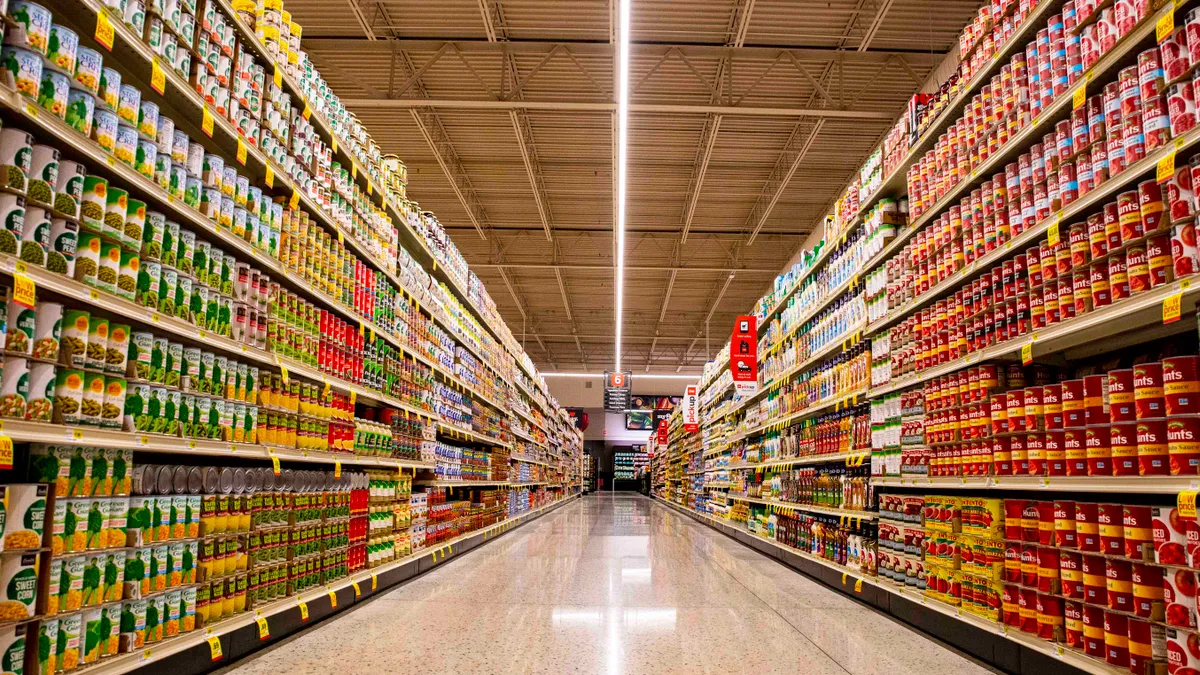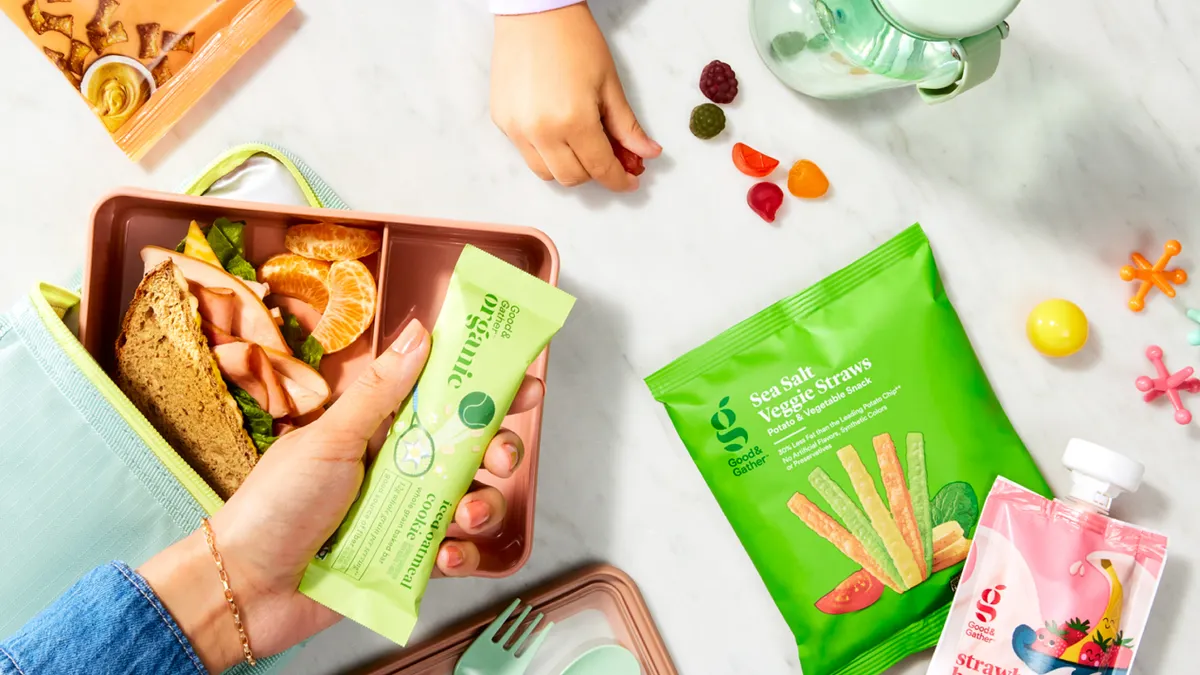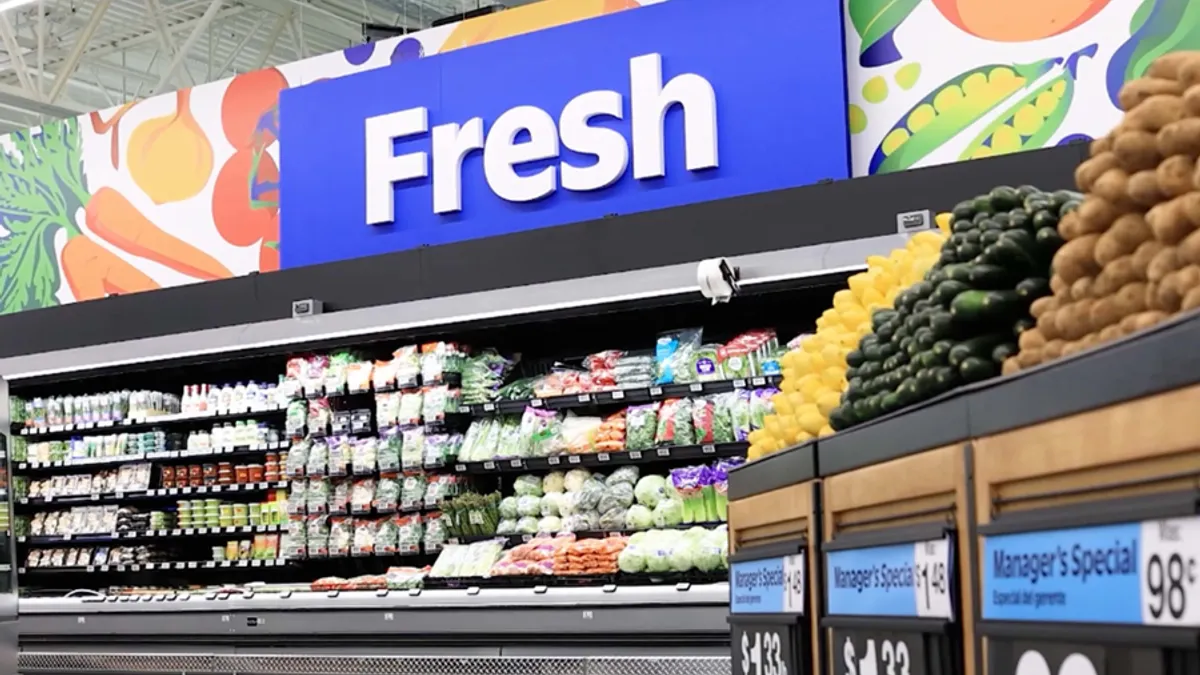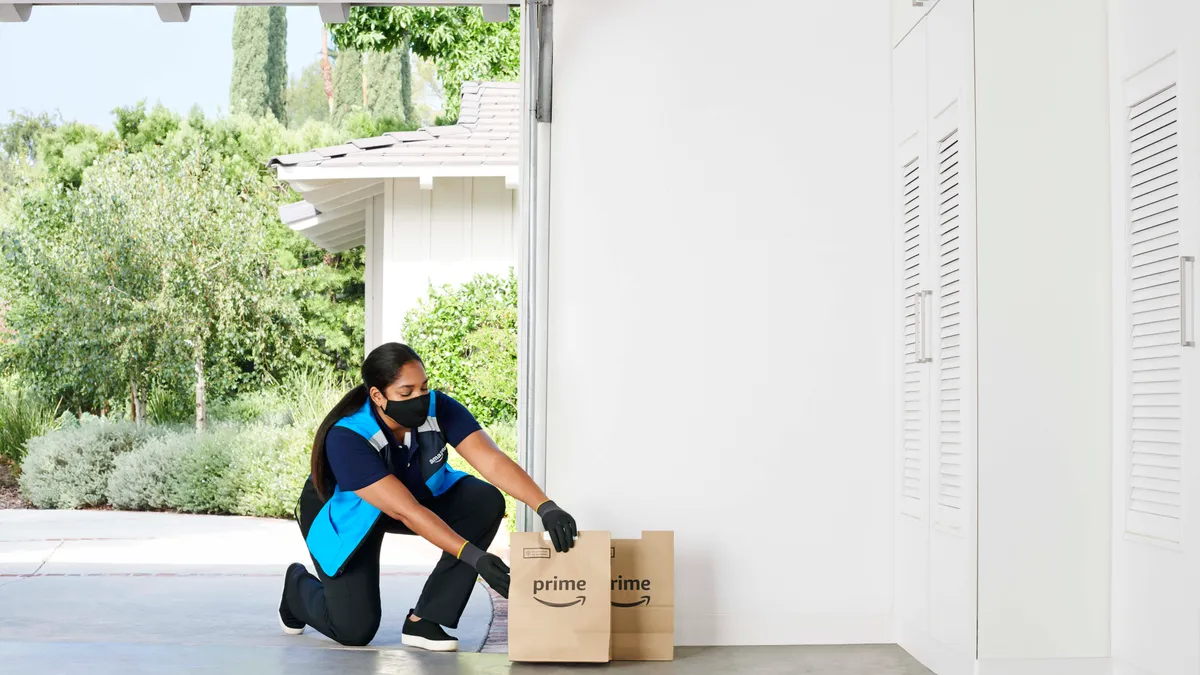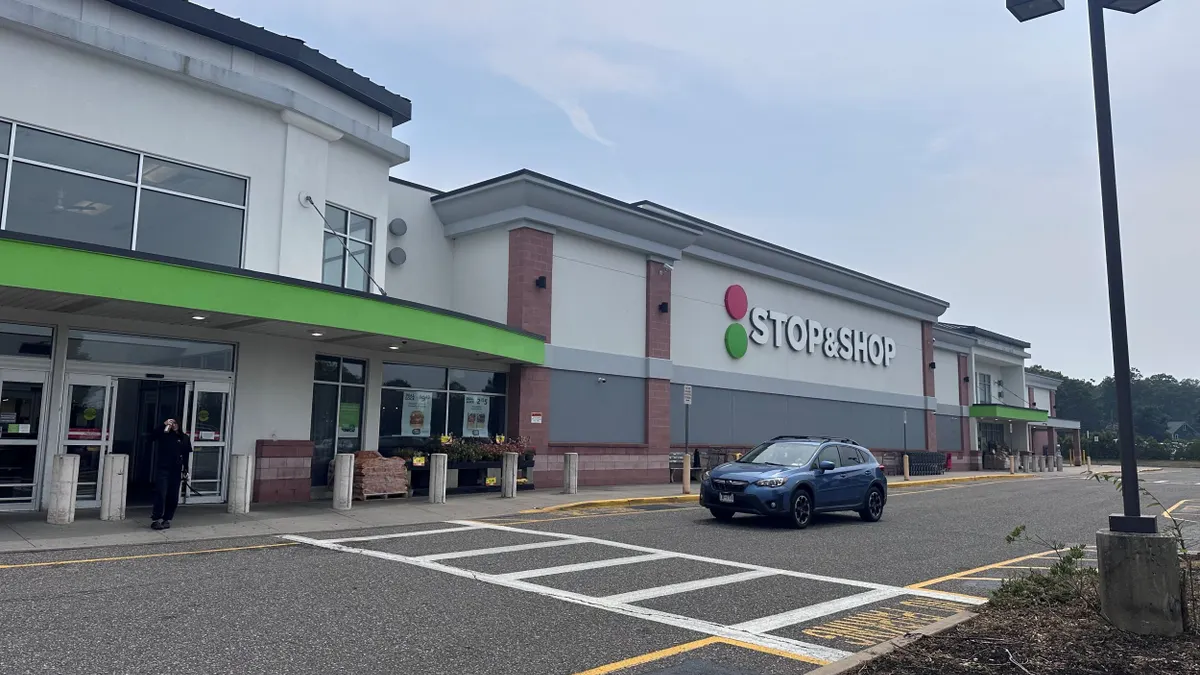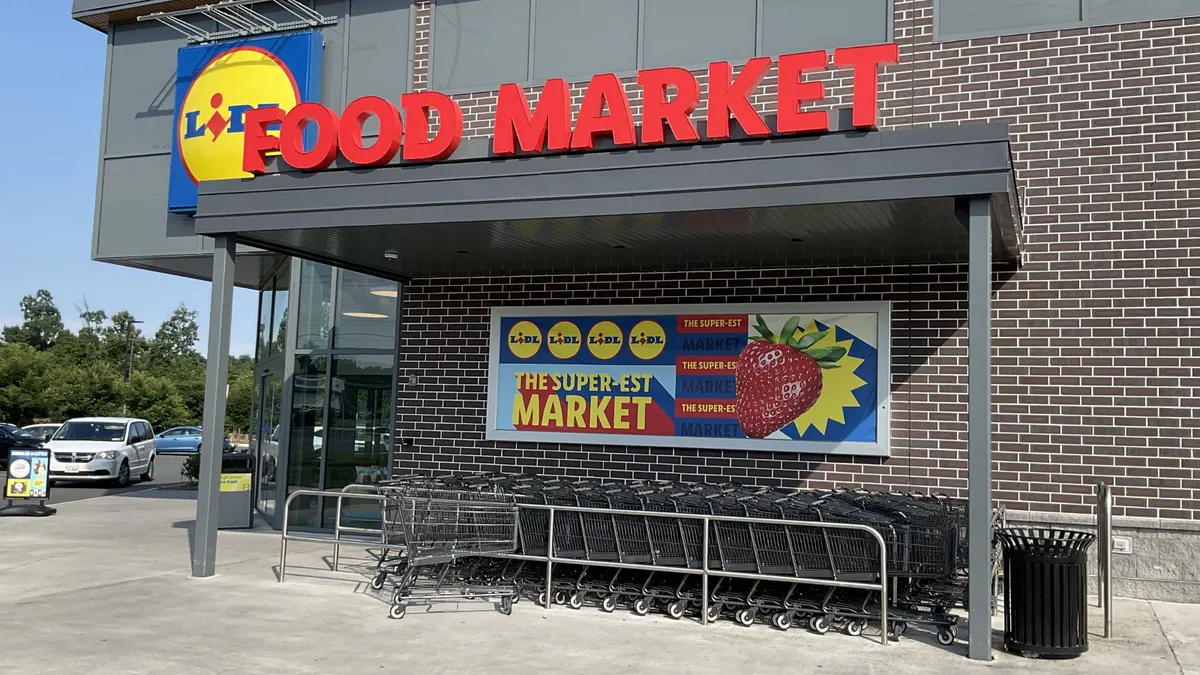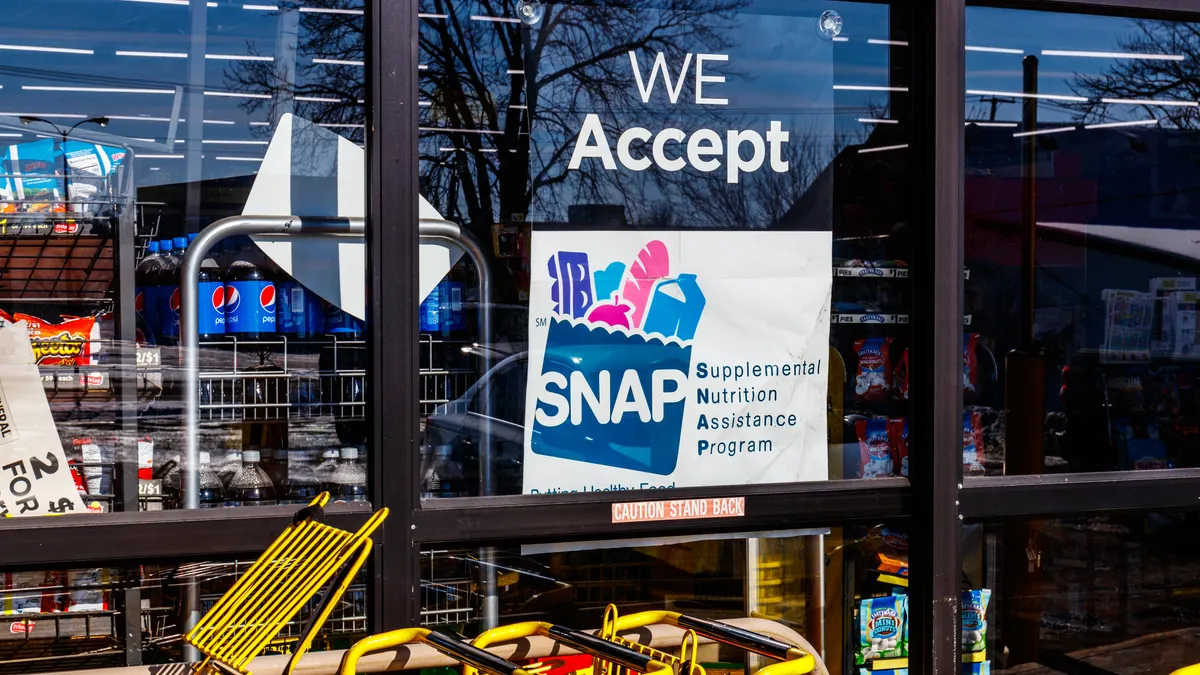This article is the first in a four-part series exploring the opportunities and challenges retailers face in center store. On Thursday, Grocery Dive will look at how retailers are adding local and emerging brands to their grocery aisles. The full series is posted here.
Center store departments that had endured stagnant returns for years roared back to life during the pandemic. Categories like frozen meals, shelf-stable foods and baking ingredients saw double-digit sales growth last year and have continued to perform above historic averages in 2021.
That performance might give grocers a false sense of security about the long-term viability of the traditional center store, with its long aisles crammed with packaged goods. But savvy retailers are seeing that they need to bring the center store into the modern era. They’re seeing consumers demand newer, more innovative products. And they’re watching them increasingly shop online — a channel where cheaper prices and faster delivery times for packaged products are just a few clicks away.
So how can retailers keep shoppers engaged with the core of their stores? And how are consumers approaching the center store as the pandemic nears the two-year mark?
To answer these and other questions, Grocery Dive, in partnership with Inmar Intelligence, surveyed 1,000 consumers and 300 grocery executives separately to gauge their attitudes toward this key department and how they’re approaching it.
The good news, according to the surveys, is that shoppers are more engaged than ever with center store. Not only do they find it a relevant place to shop, but they see themselves shopping there even more in the future.
The bad news for most grocers is that consumers are shopping online a lot more, and their local supermarket isn’t the first place they think of when buying their favorite packaged goods through e-commerce channels.
Meeting the challenge of today’s center store, the surveys suggest, requires an omnichannel strategy. Retailers need to make their center aisles more compelling places to shop. They also need to improve their digital properties, making it convenient for shoppers to add their favorite cereal or bottled drink to an order and also prompting discovery where they can.
Consumers see room for improvement, and so do retailers. Here’s what both sides have to say about the center store in 2021.
What consumers say
One of the top findings stemming from the survey is that shoppers overwhelmingly feel the center store plays a central role in how they shop for groceries. Asked if they feel the center store is relevant to the way they shop today, more than 40% of participants said it "absolutely" is.
Another 34% indicated they feel center store is "mostly" relevant to their current shopping priorities, while about a quarter said they had little or no interest in those products.
Is the grocery center store relevant to the way you shop today?
In another promising sign for retailers, the vast majority of respondents expect to buy center store products at least every other week going forward, both in-store and online. Further underscoring the high importance people place on the array of packaged goods that characterize the center store, participants were most likely to indicate that they plan to shop for those products multiple times a week — regardless of the purchasing channel they opt for.
Do you see yourself shopping center store more in the future?
In a sign that many shoppers head to the store with a pre-set shopping list and have little interest in meandering the aisles in hopes of discovering things they don't plan to buy, nearly 40% of participants in the survey chose "I only go for what I need" when questioned about how they shop the center store at brick-and-mortar retail locations.
On the other hand, about 29% of respondents said they like to browse certain center store departments, while about the same percentage indicated they "walk through the majority of center aisles" when going to the grocery store. Just 3.5% of consumers said they don't ever shop the center store.
Which of the following best describes the way you shop center store sections in-store?
While consumers in the survey indicated they shop for groceries in physical stores more often than online, the findings underscore the impact e-commerce is having on how shoppers in the United States keep their homes stocked with food and other supplies.
More than half of respondents said they shop for groceries online at least once a week, and the majority of those place an order multiple times a week. Only about 6% said they never purchase groceries through an e-commerce channel.
How often do you shop for groceries?
But in a potentially troubling sign for supermarket operators, the survey suggests that people tend not to think of their local grocery stores when heading online to buy the center store items that anchor their shopping patterns.
Asked where they direct their business when using an e-commerce channel to buy their preferred center store products, nearly 70% of people who participated in the survey said they choose Amazon, Walmart or membership-based retailers like Sam's Club or Costco. Amazon alone accounted for more than 37% of responses.
By contrast, fewer than one in 10 shoppers reported that they choose their local grocery store when placing an e-commerce order for center store staples.
Where do you buy most of your preferred center store products online?
The survey also provides a window into what shoppers would like retailers to improve about their center store offerings and offers clues about what might be turning people off to local grocers' e-commerce services.
More than 60% of participants said they'd like to have access to a better selection of products when shopping the center store in physical grocery stores, and almost as many said they felt the same way about online grocery shopping.
Beyond looking for an improved assortment, a majority of respondents said they would also like to see retailers provide better websites and apps. More than 40% also indicated they feel the product recommendation they receive when browsing for groceries online aren't up to par. And in a reflection of the preference among many shoppers for items from the area where they live, a quarter of respondents said grocers could improve the online shopping experience by adding more local and niche items.
How could center store shopping be improved inside the stores you shop?
How could center store shopping be improved online?
What retailers say
In addition to the consumer survey, Grocery Dive and Inmar also polled 300 grocery executives to get their observations on the center store’s performance during the pandemic and their outlook for the future.
In terms of sales, around a third of retailers said frozen food, which was seeing a revival before the pandemic and has since benefited from eat-at-home trends, was their top-performing department over the past year and their choice to lead sales over the next year. Shelf-stable foods took the second spot among categories and saw more retailers optimistic about its future potential.
Which center store department leads sales?
Supply-chain disruptions have impacted center store sales and assortment this year, but 78% of respondents said they believe those disruptions will improve over the coming year. Executives are also optimistic that center store sales will continue to increase over the next year, with 35% saying they expect sales to increase a little and 23% saying they expect a large increase.
How do you see center store sales performing over the coming year?
Eighty-seven percent of respondents said executives at their companies are satisfied with the center store shopping experience at their stores, reflecting a strong belief in the ability of the section to build baskets and boost profitability. An even higher percentage (92%) said they believe their shoppers are satisfied with the shopping experience, which is more or less in line with what consumers said.
Retailers are also aware of the growing challenge that Amazon and Walmart pose to their packaged goods sales. Forty-six of respondents cited Amazon, which has a robust online presence and a growing fleet of grocery stores, as the biggest threat to their center store departments, while 24% cited Walmart, which has a growing online business and massive U.S. store coverage.
What do you see as the biggest threat to your center store sales?
To meet these challenges, most retailers said they plan to update their assortments and the configuration of their center stores. More than two thirds said they aim to introduce new merchandising to the section over the next two years, while 57% said they plan on making design changes.
What changes do you plan to make to your center store departments over the next two years?
When it comes to online shopping, retailers rated shelf-stable foods, frozen meals and snacks as their top-selling categories. Although the survey didn’t cover beverages and alcohol, both of those categories have performed exceptionally well during the pandemic, with retailers deploying alcohol delivery as a separate service in some cases.
Asked which among several online enhancements they plan to implement over the next two years, respondents provided answers that were spread fairly evenly across the options. An almost equal number of retailers said they plan to launch special promotions online and introduce an updated website or app for shoppers.
A fair number of respondents also said they plan to implement personalization and auto-replenishment technology — indicating a desire to meet Walmart and Amazon on their own terms.




